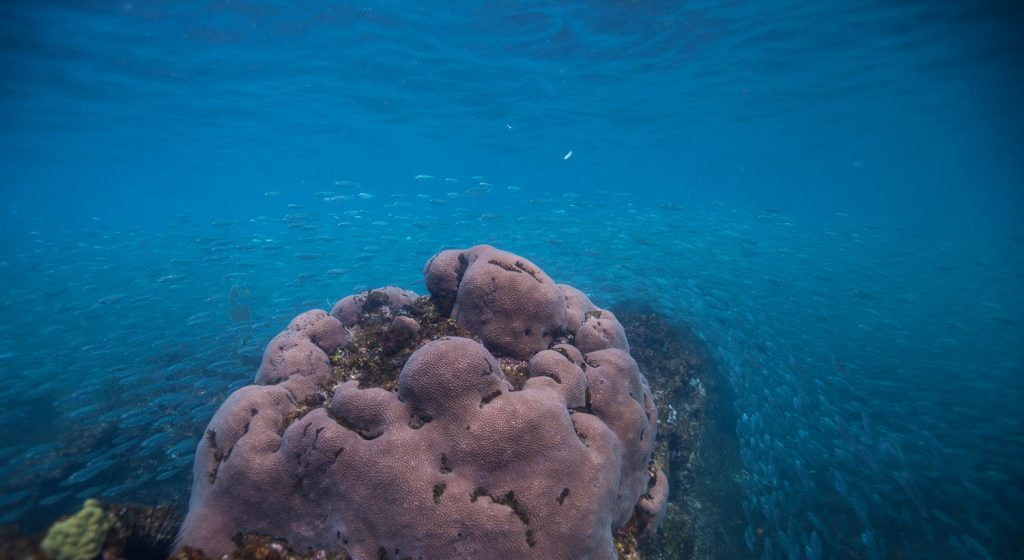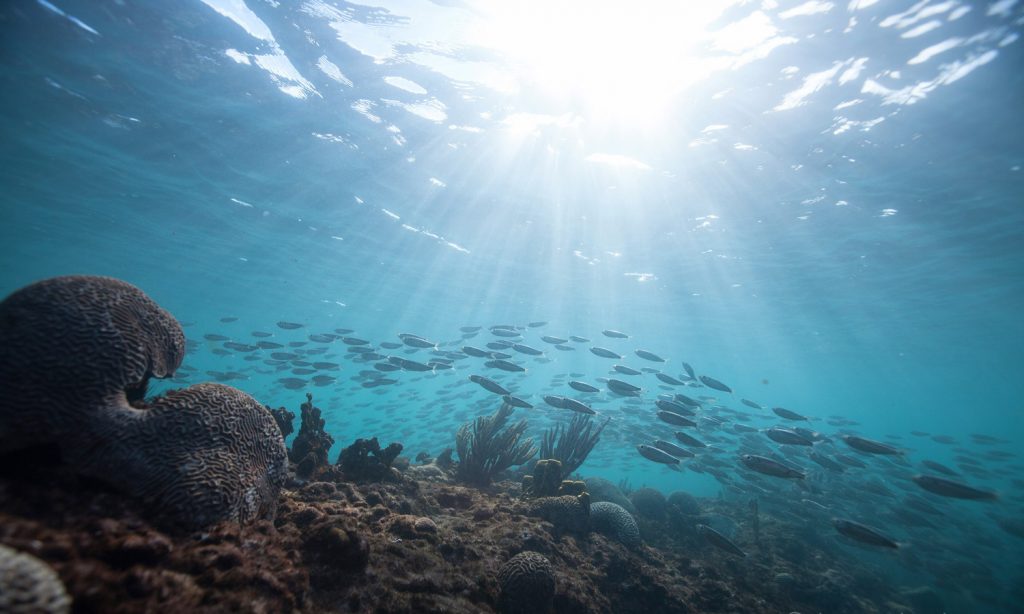
Corals
Coral reefs are remarkable natural environments and are home to a wide variety of fauna and flora. Insufficiently known, they have suffered severe degradation at the global level to the point that is estimated that currently nearly 80% of them are threatened. They are the object of several specific preservation actions within the CAYOLI program.
THE CORAL, WHAT IS IT?
What we commonly call “corals” is a living group of colonies of invertebrate marine animals, the polyps, which live in symbiosis with micro-algae, the zooxanthellae.
Polyps are animals that feed thanks to tiny tentacles that allow them to capture zooplankton. The zooxanthellae are seaweed that feeds by photosynthesis, absorbing carbon dioxide and providing nutrients to its host, the polyp.
To protect themselves, polyps create calcareous exoskeletons that are fused together to create large formations called coral communities or coral reefs. A colony of polyps is what is commonly known as a coral.
In order to develop and stay healthy corals needs special conditions: there must be enough light for the zooxanthellae to photosynthesize and the water must not exceed 29°C for more than a few weeks. Beyond this temperature, the coral undergoes stress and the polyps expel their micro-algae. Without its zooxanthellae, the polyp dies. It is then the bleaching of the colony, in other words its death.

WHICH THREATHS?
Corals are subject to different types of threats, mostly related to the consequences of human activities. In addition to pollution, global warming regularly brings water temperatures above 29°C for several weeks. This leads to the bleaching and death of coral communities. In addition, as they depend on light, episodes of major sedimentary discharges caused by floods and cyclones particularly affect them. Another important predator of corals, absent from the Caribbean region, is the starfish “Acanthaster planci”, which feeds on its tissues.
WHAT ABOUT GUADELOUPE?
Guadeloupe is bordered by coral colonies and even has the longest barrier reef in the Lesser Antilles in the Grand Cul-de-sac Marin. It measures nearly 29 km and is home to 57 species of corals, 40 species of sponges and 30 species of gorgonians. In 2018, only 10% of the corals are healthy and 80% of the corals are in critical condition.
THE DIFFERENT TYPES OF REEFS
There are several types of coral reefs:
- Fringing reefs that is directly adjacent or very close to the coast.
- Barrier reefs which are wide structures, at variable distances from the coast and have a depth of between 10 and 70 m. Guadeloupe is home to the longest barrier reef in the West Indies with nearly 29 km.
- The atolls, which are deep-sea reefs, circular in shape with a lagoon in their center.
WHERE DO WE FIND THEM?
Throughout the world, coral reefs are found in tropical and subtropical areas where the environmental conditions are favorable for their development (between 30° North and 30° South).
Two zones present an important concentration:
- The Caribbean Basin, which extends from Bermuda to Brazil and includes the Gulf of Mexico.
- The Indo-Pacific basin, which extends from the Indian Ocean to French Polynesia.
In Guadeloupe, with a few exceptions, there are coral communities from 0 to -35m, with maximum development between -10 and -25/30m. Their composition and diversity vary according to depth and their location in relation to the coastline.
Globally, reefs located close to shore are subject to greater variations in their development conditions. In addition, beyond 35m, corals are scarcer, light being less important to become almost non-existent beyond 65m.
HOW ARE THEY PROTECTED?
Corals cover 0.1% of the sea surface, but produce more than 25% of the fish caught in the world! Coral reefs are therefore of particular economic importance. Unfortunately, the Deer horn coral (Acropora cervicornis) and the Moose horn coral (Acropora palmata), building corals with rapid three-dimensional growth, have almost disappeared from Guadeloupean waters in less than 20 years and are now in critical danger of extinction.
Corals are the subject of special attention in terms of conservation in Guadeloupe. They are included in particular on the red list of the IUCN (International Union for Conservation of Nature). The two species targeted by the Cáyoli project, Acropora palmata and Acropora cervicornis, are classified as “critically endangered” on this reference list.
Two prefectoral decrees govern the protection of corals: the decree of August 19, 2002 (n°2002-1249) which prohibits the collection and sale of corals “of all times and in all places” and the decree of April 25, 2017 which establishes the list of protected corals in Guadeloupe, Martinique and St. Martin, as well as the modalities of their protection.
ASSOCIATED FAUNA AND FLORA
A place of abundant life, coral reefs can be compared to the trees of the Amazon rainforest: few species feed directly on them, but they allow a rich and abundant fauna to live by forming complex ecosystems without equal in the marine world. In Guadeloupe, nearly 250 species of fish depend directly on them!


